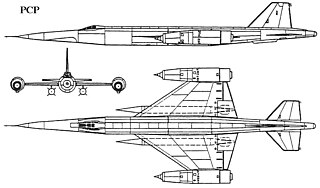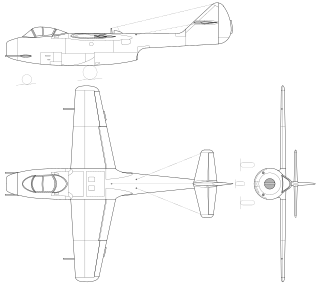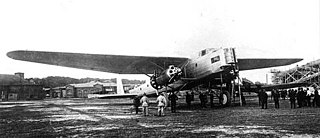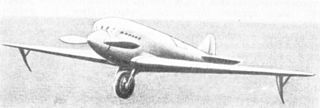Related Research Articles
Pre-revolutionary Imperial Russia did not have a single national unified system but instead relied on those provided by the manufacturers of the aircraft, like Sikorsky Ilya Muromets or Anatra Anasal.

The Central Aerohydrodynamic Institute was founded in Moscow by Russian aviation pioneer Nikolai Yegorovich Zhukovsky on December 1, 1918.

The Tupolev ANT-20 Maxim Gorky was a Soviet eight-engine aircraft, the largest in the world during the 1930s. Its wingspan was similar to that of a modern Boeing 747, and was not exceeded until the 64.6-metre (212 ft) wingspan Douglas XB-19 heavy bomber prototype first flew in 1941.

The Tupolev TB-1 was a Soviet bomber aircraft, an angular monoplane that served as the backbone of the Soviet bomber force for many years, and was the first large all-metal aircraft built in the Soviet Union.

The Tsybin RSR was a Soviet design for an advanced, long-range, Mach 3 strategic reconnaissance aircraft.

The Lavochkin La-150, was designed by the Lavochkin design bureau (OKB) in response to a 1945 order to build a single-seat jet fighter using a single German turbojet. By this time both the Americans and British, as well as the Germans, had already flown jet fighters and the single Soviet jet engine under development was not yet ready for production. The design was completed quickly, but the construction of the five flying prototypes was protracted by the factory's inexperience in building metal aircraft. The aircraft made its first flight in September 1946, but proved to require extensive modifications to meet the Soviet Air Forces' requirements. These took so long to make and test that the aircraft was essentially obsolete by the time that they were completed. Even one variant with a much more powerful engine was inferior to other aircraft that the OKB had under development and all work was terminated in 1947.
The Sukhoi Su-10 or Izdeliye Ye was a Soviet turbojet-powered bomber aircraft built shortly after World War II.
OKB Chyetverikov was a Soviet aircraft design bureau headed by designer Igor Vyacheslavovich Chyetverikov at the TsAGI Menzhinskii factory in 1931 in order to produce flying boat designs.

The Grigorovich TB-5 was an experimental heavy bomber designed and tested in the Soviet Union in the early 1930s. Designed as a competitor for the Tupolev TB-3, the TB-5 was intended to be powered by two FED 24-cylinder X engines of 746 kW (1,000 hp) each. When these were canceled, the underwing pods were revised to each house a pair of Bristol Jupiter engines in a push-pull configuration. Despite projected performance inferior to TB-3, it was hoped that TB-5 would gain an advantage by using less metal thanks to its mixed construction of fabric-covered metal frame.

The Kalinin K-7 was a heavy experimental aircraft designed and tested in the Soviet Union in the early 1930s. It was of unusual configuration, with twin booms and large underwing pods housing fixed landing gear and machine gun turrets. In the passenger version, seats were arranged inside the 2.3-meter thick wings. The airframe was welded from KhMA chrome-molybdenum steel. The original design called for six engines in the wing leading edge, but when the projected loaded weight was exceeded, two more engines were added to the trailing edges of the wing, one right and one left of the central passenger pod. Nemecek states in his book that at first only one further pusher engine was added.
Tupolev TB-6 was a proposal by the Tupolev Design Bureau in the 1930s for a super-heavy bomber. Had it been built, it would have been the biggest-ever Soviet bomber and the largest aircraft by wingspan of its time, nine feet short of the 320 foot span of the Hughes H-4 Hercules, although the Scaled Composites Stratolaunch is now the biggest plane by wingspan.

The Polikarpov I-17 was a Soviet single-seat fighter prototype designed and built by a team headed by Polikarpov at the Central Design Bureau (TsKB)
The Nikitin NV-1 was a single-seat sporting aircraft produced in the USSR in 1933.
The Belyayev Babochka, was a tandem seat research aircraft designed in the USSR from 1939.

The DAR, was a twin-engined flying boat designed and produced in the USSR from 1934.

The Bartini Stal-6, was a single-engined experimental aircraft designed, built and tested in the USSR from 1930.

The SPL was a submarine borne flying boat designed and built in the USSR from 1931.
The BOK-1, , was an experimental high-altitude aircraft designed and built in the USSR from 1934.
The Ilyushin DB-4 or TsKB-56 was a Soviet twin-engined bomber aircraft of the early 1940s. It was a development of the Ilyushin DB-3 and was intended as a replacement for the earlier aircraft, but only two prototypes were built; engine problems and the need to concentrate production on existing types following the German invasion of the Soviet Union in June 1941 meant that no more examples were built.